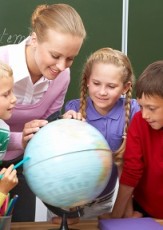 This is the second in a multi-part exploration of the perceived disconnect between school and “real life,” with an eye toward drawing students into greater, deeper, and keener engagement with school learning. (See my post of March 17th for Part One.)
This is the second in a multi-part exploration of the perceived disconnect between school and “real life,” with an eye toward drawing students into greater, deeper, and keener engagement with school learning. (See my post of March 17th for Part One.)
* * *
A half-thousand years ago, I was a student teacher in Madison, Wisconsin. I remember the experience far too well; I’d guess (hope) my students don’t remember it at all.
Not five years older than they were, I was terrified—concerned about losing control of the class; apprehensive about being ineffective; worried about looking stupid, or —heaven forbid — actually tripping over my own feet. My response to these feelings was to adopt what I believed (incorrectly) was a “teacher persona.” I was strict, humorless, and no-nonsense. I’m absolutely certain I did nothing to deepen, enrich, or ignite my students’ interest in the subject matter. Most days I looked out at a sea of empty eyes and teens with flat affect, flaccid arms, and meek voices. It wasn’t fun, and it wasn’t good.
Fast forward a few decades to days as an instructor of undergraduate students in science education. No longer terrified, I had figured out that it was okay to leave the persona behind and be “myself.” The course curriculum was rigorous. While reporting on the Science Section of the New York Times; researching, writing, testing, and revising a science unit; observing mealworms; exploring the surface tension of water; building models; and creating data sheets; we discussed, compared, laughed, and occasionally lost our footing. Instead of a sea of empty eyes, before me was an ocean of raised hands. It was fun, it was good, and my students learned.
I believe one of the differences in these two experiences was in the way I used my position as teacher. In the latter setting, I related to my students as a person, not a persona. I used my authority to lead, not control, noting that the control came on its own from them. There was nothing artificial in my behavior. In return, my students connected with the experience in real ways, integrating themselves into it, rather than remaining satellites to it.
I feel there’s a lesson here.
By definition we, as teachers, are authority figures. We are present in the classroom precisely because we have knowledge and the skills to help our students acquire it. Still, we can choose the way we exert our authority. We can take a military-like approach as I did when I was student teaching. Or, we can take a more authentic approach by connecting with learners as the robust individuals they are—with traits, interests, and propensities very much their own.
Moving from persona to person isn’t as difficult as it may seem. Michael Kline, in his March 6th post, discusses one of many ways to take steps in that direction. In the post, Michael points out the value of allowing students to see us as learners ourselves, of sharing our own learning experiences with them, and inviting them to share theirs in return. Tacit in his suggestion is that we too are students, and in this sense allied with our own students.
Another strategy concerns feedback. Allow two minutes at the end of each class for everyone to write (anonymous) feedback. You, too. Try varying the focus. Students can summarize what they got out of a lesson, or describe their favorite/most challenging part and why. They can identify what still remains unclear. For your part, you may want to write about what you feel went well, what you might change, or how you felt students responded. Share and discuss the comments. Consciously or not, this is very much how we connect with friends and colleagues outside of school. There’s good reason to bring it inside.
Further still, make a conscious effort to find out more about your students. Observe them. Take note of how they relate to one another. What are their likes and dislikes? Who’s fashion-conscious? Who’s not? What are their passions? By paying attention to our students in these non-academic ways, we round out our sense of them as individuals and can begin to connect with them accordingly.
When we embrace our students in these real-world ways and bring our authentic selves to the teaching/learning experience, we go a long way toward helping students merge school life with “real life.” And that’s a good thing.
